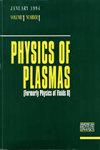碰撞交叉场间隙中的极限电流
IF 2.2
3区 物理与天体物理
Q3 PHYSICS, FLUIDS & PLASMAS
引用次数: 0
摘要
交叉磁场设备通常用于脉冲功率和高功率微波应用中。之前的研究推导出了真空交叉磁场系统极限电流的闭式解,对应于层流的最大允许电流,低于和高于磁绝缘的赫尔截止 BH。我们通过在电子力定律中引入碰撞频率作为摩擦项来扩展这些研究,从而推导出碰撞交叉场间隙中的极限电流。由此得到的解恢复了无碰撞极限下的真空交叉场情况,以及磁场 B→0 时具有一般初始速度的碰撞空间电荷极限电流。在无限碰撞的极限中,我们得到了碰撞非磁性二极管中允许的最大电流的交叉场等效于莫特-格尼定律。当碰撞频率ν小于电子回旋频率Ω时,初速度的增加会使临界电流随ν的增加而非单调,当ν=Ω时,临界电流在B=BH时更大。对于错位交叉磁场间隙,磁场的分量与间隙上的电场平行,磁绝缘被消除,在真空交叉磁场间隙中观察到的极限电流 B=BH 处的不连续性消失了。当 B→∞ 时,极限电流接近一个常数,该常数取决于初始速度和碰撞频率。本文章由计算机程序翻译,如有差异,请以英文原文为准。
Limiting current in a collisional crossed-field gap
Crossed-field devices are often used in pulsed power and high-power microwave applications. Previous studies derived closed-form solutions for the limiting current of a vacuum crossed-field system, corresponding to the maximum permissible current for laminar flow, below and above the Hull cutoff BH for magnetic insulation. We extend these studies by introducing collision frequency into the electron force law as a friction term to derive the limiting current in a collisional crossed-field gap. The resulting solution recovers the vacuum crossed-field case in the limit of no collisions and the collisional space-charge limited current with general initial velocity for magnetic field B→0. In the limit of infinite collisions, we obtain a crossed-field equivalent to the Mott–Gurney law for the maximum current permissible in a collisional, nonmagnetic diode. When the collision frequency ν is less than the electron cyclotron frequency Ω, increasing initial velocity makes the critical current nonmonotonic with increasing ν with the critical current higher at B=BH for ν=Ω. As for a misaligned crossed-field gap where a component of the magnetic field was introduced parallel to the electric field across the gap, magnetic insulation is eliminated and the discontinuity at B=BH for limiting current observed in a vacuum crossed-field gap vanishes. As B→∞, the limiting current approaches a constant that depends on the initial velocity and the collision frequency.
求助全文
通过发布文献求助,成功后即可免费获取论文全文。
去求助
来源期刊

Physics of Plasmas
物理-物理:流体与等离子体
CiteScore
4.10
自引率
22.70%
发文量
653
审稿时长
2.5 months
期刊介绍:
Physics of Plasmas (PoP), published by AIP Publishing in cooperation with the APS Division of Plasma Physics, is committed to the publication of original research in all areas of experimental and theoretical plasma physics. PoP publishes comprehensive and in-depth review manuscripts covering important areas of study and Special Topics highlighting new and cutting-edge developments in plasma physics. Every year a special issue publishes the invited and review papers from the most recent meeting of the APS Division of Plasma Physics. PoP covers a broad range of important research in this dynamic field, including:
-Basic plasma phenomena, waves, instabilities
-Nonlinear phenomena, turbulence, transport
-Magnetically confined plasmas, heating, confinement
-Inertially confined plasmas, high-energy density plasma science, warm dense matter
-Ionospheric, solar-system, and astrophysical plasmas
-Lasers, particle beams, accelerators, radiation generation
-Radiation emission, absorption, and transport
-Low-temperature plasmas, plasma applications, plasma sources, sheaths
-Dusty plasmas
 求助内容:
求助内容: 应助结果提醒方式:
应助结果提醒方式:


